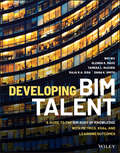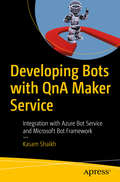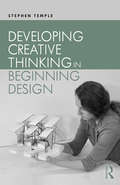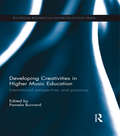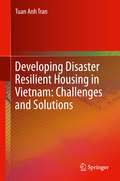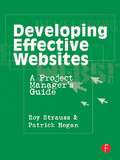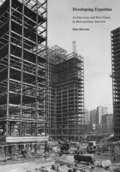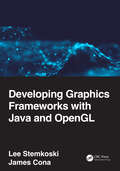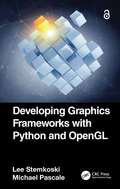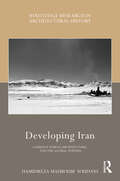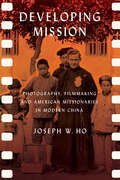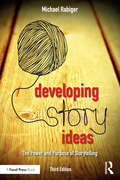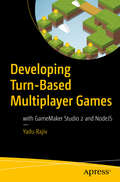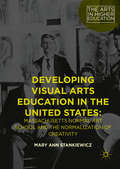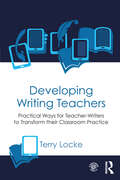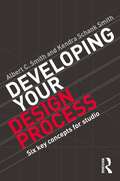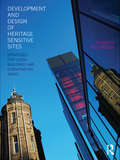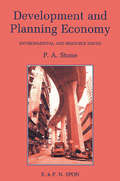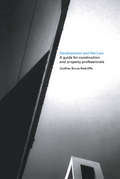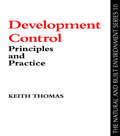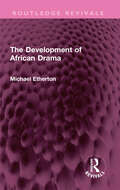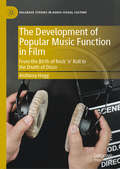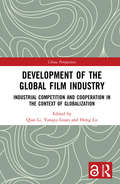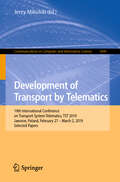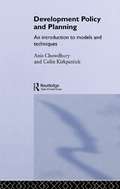- Table View
- List View
Developing BIM Talent: A Guide to the BIM Body of Knowledge with Metrics, KSAs, and Learning Outcomes
by Wei Wu Dana K. Smith Glenda K. Mayo Tamera L. McCuen Raja R. IssaA systematic Building Information Modeling (BIM) framework features cutting-edge use cases and competencies for students and professionals pursuing BIM careers. Developing BIM Talent: A Guide to the BIM Body of Knowledge with Metrics, KSAs, and Learning Outcomes leads readers through the process of implementing a state-of-the-art BIM training and education program. Authored by a team of celebrated and highly qualified scholars and practitioners, this exciting new BIM education and workforce development guide offers a roadmap that navigates readers through the comprehensive BIM metrics and KSAs detailed in the BIM Body of Knowledge sponsored by the Academic Interoperability Coalition (AiC). Developing BIM Talent offers: A solid foundation and guidelines for educators and practitioners for starting or enhancing a BIM curriculum or training program Templates, expert interviews, and case studies that provide in-depth knowledge and lessons learned that can facilitate process changes and strategic action plans Strategies for standardizing emerging BIM job tasks, descriptions, and methods for benchmarking performance This guide to contemporary and comprehensive metrics of BIM competency is an essential resource for corporate trainers and instructors teaching BIM, human resources professionals charged with recruiting BIM talent, as well as leadership interested in credentialing and BIM certification programs.
Developing Bots with QnA Maker Service: Integration with Azure Bot Service and Microsoft Bot Framework
by Kasam ShaikhLearn to develop bots with zero coding knowledge using the Azure Cognitive QnA Maker service, a GUI cognitive service from Microsoft. This book shows you how to integrate QnA Maker with the Azure Bot Service and Microsoft Bot Framework, along with how to integrate your bot with social channels such as Web Chat, and Telegram. You will learn what QnA Maker is, why you should use this service in enterprise settings, when you should use this service, and how you should use the service. Developing Bots with QnA Maker Service takes you through the QnA Maker FAQ knowledge base with Azure Bot Service, where you will discover how to get started with a web app bot using the Azure portal. This section culminates in deploying your bot on Azure Web App, making your bot live. Next, you will learn QnA Maker with the .NET Framework and Visual Studio 2017 along with ways to manage QnA Maker service post deployment. Finally, you will learn how to add media content including videos and images to the QnA Maker knowledge base. After reading this book you will be able to develop bots using the latest .NET Framework, Visual Studio 2017, and the Microsoft online code editor. What You Will LearnCustomize QnA Maker default components, using the Azure portalWork with Microsoft Bot FrameworkDevelop and integrate FAQ bots with Azure Bot ServiceManage FAQ bots using the .NET Framework and the Azure portalWho This Book Is ForDevelopers/architects with an interest in building chatbots.
Developing Creative Thinking in Beginning Design
by Stephen TempleLearning to think and act creatively is a requisite fundamental aspect of design education for architectural and interior design as well as industrial and graphic design. Development of creative capacities must be encountered early in design education for beginning students to become self-actualized as skillful designers. With chapters written by beginning design instructors, Developing Creative Thinking in Beginning Design addresses issues that contribute to deficiencies in teaching creativity in contemporary beginning design programs. Where traditional pedagogies displace creative thinking by placing conceptual abstractions above direct experiential engagement, the approaches presented in this book set forth alternative pedagogies that mitigate student fears and misconceptions to reveal the potency of authentic encounters for initiating creative transformational development. These chapters challenge design pedagogy to address such issues as the spatial body, phenomenological thinking, making as process, direct material engagement and its temporal challenges, creative decision making and the wickedness of design, and the openness of the creative design problem. In doing so, this book sets out to give greater depth to first design experiences and more effectively enable the breadth and depth of the teacher–student relationship as a means of helping your students develop the capacity for long-term self-transformation.
Developing Creativities in Higher Music Education: International Perspectives and Practices (Routledge Research in Higher Education)
by Pamela BurnardThis is the first book to critically address the issue of how we can enhance and develop creativities in higher music education. It features new international, richly diverse perspectives on the nature and practice of creativities in different cultural and institutional contexts, in varying roles and in response to diverse professional pressures and expectations of artistic and educational achievement. This compelling and provocative book combines powerful social and educational commentaries and examples drawn from international sources based on original practices and experience of a diversity of creativities. The authors provide an important contribution by drawing attention to what is at the heart of all music and how we can understand and foster these multiple creativities at an individual and institutional level. It features new analyses of the question of creativities in higher music education, and offers illustrative and innovative examples of adaptive learning environments for teaching and learning creatively, considering the broader issue of the role of creativities in relation to educational policy in the context of increasingly interventionist governments and rapidly paced educational change. Topics covered include: -the conceptual tools for people to think about and debate multiple creativities -the role of creativities in higher music education-how musicians can develop multiple creativities in new ways -new approaches to teaching and learning for multiple creativities -what constitute leadership creativities in conservatoires and music departments-creativities at the interface of institutional learning cultures-assessing the multiple creativities of music. Developing Creativities in Higher Music Education offers a multi-disciplinary research and practice focus, which will be essential reading for anyone involved in higher education and industry sectors. The book will appeal to academics and practitioners in music, researchers, instrumental and vocal teachers, curriculum and policy developers and institutional managers who want to enrich the higher education experiences of their students and enable them to develop more of their creative potential. It is also ideal reading for undergraduate and postgraduate students of music education who are looking for an authoritative selection of writings that define the fields of musical creativities in one comprehensive volume.
Developing Disaster Resilient Housing in Vietnam: Challenges and Solutions
by Tuan Anh TranThis book provides a comprehensive understanding on disaster resilient housing within the Vietnam context particularly and the developing world generally. The book has identified the root causes of housing vulnerability, restrictions to safe housing development, concepts of disaster resilient housing, key issues/factors implementers and building designers need to consider, and ways of achieving resilient housing outcomes in actual design projects. The design and development of disaster resilient housing has been framed into three main themes: (i) community consultation, (ii) the role of built-environment professionals and (iii) design responses for resilience. To achieve these themes, there is a variety of contextual and intervening conditions that need to be addressed and met to provide an enabling environment for promoting disaster resilient housing. These three themes are among the most arguable issues in recent debates and discussions, academically and practically, regarding disaster risk reduction and safe housing development. In addition, this book also provides the evidence-based design framework for disaster resilient housing upon which design ideas and solutions for safe and resilient housing can be generated and shaped.
Developing Effective Websites: A Project Manager's Guide
by Patrick Hogan Roy StraussIs your website project out of control?Every website project needs a manager. Developing Effective Websites describes Internet technologies in plain language and helps you see beyond your expertise to the big picture. It does this by drawing on established software project and management principles. Like any project, effective management of website development starts by understanding and balancing the constraints of time, resources, and tasks. You can deliver your project on time and on budget, by following a process that includes:· Analyzing the requirements of users and your market· Developing a workplan for the site and breaking it down to tasks· Scheduling with Gantt and PERT charts and measuring slippage for more accurate revisions· Estimating cost by the budget-first or design-first methods · Using the team development process and covering all the necessary roles· Aligning contractor and client interests to create a win-win relationship· Following an iterative development process for designing, prototyping, and building out· Applying software testing principles to website development· Making hosting decisions and planning for maintenance
Developing Expertise
by Sara StevensReal estate developers are integral to understanding the split narratives of twentieth-century American urban history. Rather than divide the decline of downtowns and the rise of suburbs into separate tales, Sara Stevens uses the figure of the real estate developer to explore how cities found new urban and architectural forms through both suburbanization and urban renewal. Through nuanced discussions of Chicago, Kansas City, Detroit, Pittsburgh, Denver, Washington, D. C. , and New York, Stevens explains how real estate developers, though often maligned, have shaped public policy through professional organizations, promoted investment security through design, and brought suburban models to downtowns. In this timely book, she considers how developers partnered with prominent architects, including Ludwig Mies van der Rohe and I. M. Pei, to sell their modern urban visions to the public. By viewing real estate developers as a critical link between capital and construction in prewar suburban development and postwar urban renewal, Stevens offers an original and enlightening look at the complex connections among suburbs and downtowns, policy, finance, and architectural history.
Developing Graphics Frameworks with Java and OpenGL
by Lee Stemkoski James ConaDeveloping Graphics Frameworks with Java and OpenGL shows you how to create software for rendering complete three-dimensional (3D) scenes. The book explains the foundational theoretical concepts as well as the practical programming techniques that will enable you to create your own animated and interactive computer-generated worlds. You will learn how to combine the power of OpenGL, the most widely adopted cross-platform application programming interface (API) for graphics processing unit (GPU) programming, with the accessibility and versatility of the Java programming language. Topics in this book include generating geometric shapes, transforming objects with matrices, applying image-based textures to surfaces, and lighting a scene. Advanced sections explain how to implement procedurally generated textures, postprocessing effects, and shadow mapping. In addition to the sophisticated graphics framework discussed throughout the book, you will gain a foundational knowledge that will allow you to adapt and extend that framework, leading to even more spectacular graphical results. Author bios Lee Stemkoski is a professor of mathematics and computer science. He earned his Ph.D. in mathematics from Dartmouth College in 2006 and has been teaching at the college level since. His specialties are computer graphics, video game development, and virtual and augmented reality programming. James Cona is an up-and-coming software engineer who studied computer science at Adelphi University. Some of his specific interests include music, video game programming, 3D graphics, artificial intelligence, and clear and efficient software development in general.
Developing Graphics Frameworks with Python and OpenGL
by Lee Stemkoski Michael PascaleDeveloping Graphics Frameworks with Python and OpenGL shows you how to create software for rendering complete three-dimensional scenes. The authors explain the foundational theoretical concepts as well as the practical programming techniques that will enable you to create your own animated and interactive computer-generated worlds. You will learn how to combine the power of OpenGL, the most widely adopted cross-platform API for GPU programming, with the accessibility and versatility of the Python programming language. Topics you will explore include generating geometric shapes, transforming objects with matrices, applying image-based textures to surfaces, and lighting your scene. Advanced sections explain how to implement procedurally generated textures, postprocessing effects, and shadow mapping. In addition to the sophisticated graphics framework you will develop throughout this book, with the foundational knowledge you will gain, you will be able to adapt and extend the framework to achieve even more spectacular graphical results.
Developing Iran: Company Towns, Architecture, and the Global Powers (Routledge Research in Architectural History)
by Hamidreza Mahboubi SoufianiThis book examines the emergence of modern company towns in Iran by delineating the architectural, political, and industrial histories of three distinct resource-based ‘company town’ projects built in association with the ‘Big Three’ powers of World War II. The book’s narrative builds upon a tripartite research design that chronologically traces the formation and development of the oil, steel, and copper industries, respectively favoured by Great Britain, the Soviet Union, and the United States in this part of the world. By applying three sets of comparative studies, the book provides critical vantage points to three different ideological design paradigms: postcolonial regionalism, socialist universalism, and rationalist modern nation building. From a global political context, the book contributes to the disclosure of new information about the geopolitical confrontation of these three nations in the Global South to increase their sphere of influence after the Second World War. Furthermore, it demonstrates how postwar architectural modernism was adopted by each power and adapted to their ideological mind frame to fulfil distinct social, cultural, political, and economic targets. This book examines multiple interconnections between architecture, politics, and industrial development by adopting a transdisciplinary approach based on comprehensive fieldwork, site surveys, and the analysis of original multilingual documents. As such, it will be of interest to researchers and students of architecture, history, international relations, and Middle Eastern studies.
Developing Mission: Photography, Filmmaking, and American Missionaries in Modern China (The United States in the World)
by Joseph W. HoIn Developing Mission, Joseph W. Ho offers a transnational cultural history of US and Chinese communities framed by missionary lenses through time and space—tracing the lives and afterlives of images, cameras, and visual imaginations from before the Second Sino-Japanese War through the first years of the People's Republic of China. When American Protestant and Catholic missionaries entered interwar China, they did so with cameras in hand. Missions principally aimed at the conversion of souls and the modernization of East Asia, became, by virtue of the still and moving images recorded, quasi-anthropological ventures that shaped popular understandings of and formal foreign policy toward China. Portable photographic technologies changed the very nature of missionary experience, while images that missionaries circulated between China and the United States affected cross-cultural encounters in times of peace and war. Ho illuminates the centrality of visual practices in the American missionary enterprise in modern China, even as intersecting modernities and changing Sino-US relations radically transformed lives behind and in front of those lenses. In doing so, Developing Mission reconstructs the almost-lost histories of transnational image makers, subjects, and viewers across twentieth-century China and the United States.
Developing Story Ideas: The Power and Purpose of Storytelling
by Michael RabigerThe vast majority of screenplay and writing books that focus on story development have little to say about the initial concept that inspired the piece. Developing Story Ideas: The Power and Purpose of Storytelling, Third Edition provides writers with ideational tools and resources to generate a wide variety of stories in a broad range of forms. Celebrated filmmaker and author Michael Rabiger demonstrates how to observe situations and themes in the writer's own life experience, and use these as the basis for original storytelling. This new edition has been updated with chapters on adaptation, improvisation, and cast collaboration's roles in story construction, as well as a companion website featuring further projects, class assignments, instructor resources, and more. Gain the practical tools and resources you need to spark your creativity and generate a wide variety of stories in a broad range of forms, including screenplays, documentaries, novels, short stories, and plays Through hands-on, step-by-step exercises and group and individual assignments, learn to use situations and themes from your own life experience, dreams, myth, and the news as the basis for character-driven storytelling; harness methods of screenplay format, dialogue, plot structure, and character development that will allow your stories to reach their fullest potential
Developing Turn-Based Multiplayer Games: with GameMaker Studio 2 and NodeJS
by Yadu RajivCreate your first turn-based multiplayer game using GameMaker Studio 2’s built-in networking functions as well as using a simple NodeJS server. This book introduces you to the complexities of network programming and communication, where the focus will be on building the game from the ground up. You will start with a brief introduction to GameMaker Studio 2 and GML coding before diving into the essential principles of game design. Following this, you will go through an introductory section on NodeJS where you will learn how to create a server and send and receive data from it as well as integrating it with GameMaker Studio. You will then apply multiplayer gaming logic to your server and unlock multiplayer game features such as locating a player, syncing their data, and recording their session. What You Will LearnDiscover the architecture of GameMaker Studio 2 Add new features to your game with NodeJS modulesIntegrate GameMaker Studio 2 with NodeJS Master GameMaker Studio 2's built-in networking functionsWho This Book Is ForGameMaker Studio users who want to understand how the networking components of GMS 2 work. Basic JavaScript knowledge is required.
Developing Visual Arts Education in the United States
by Mary Ann StankiewiczThis bookexamines how Massachusetts Normal Art School became the alma mater par excellencefor generations of art educators, designers, and artists. The founding myth ofAmerican art education is the story of Walter Smith, the school's firstprincipal. This historical case study argues that Smith's students formed theprofessional network to disperse art education across the United States,establishing college art departments and supervising school art for industrialcities. As administrative progressives they created institutions and set normsfor the growing field of art education. Nineteenth-century artists argued thatanyone could learn to draw; by the 1920s, every child was an artist whosecreativity waited to be awakened. Arguments for systematic art instructionunder careful direction gave way to charismatic artist-teachers who sought torelease artistic spirits. The task for art education had been redefined interms of living the good life within a consumer culture of work and leisure.
Developing Writing Teachers: Practical Ways for Teacher-Writers to Transform their Classroom Practice
by Terry LockeThe premise of Developing Writing Teachers is this: When teachers of writing identify as writers, it adds a special dimension to their writing pedagogy. Practical and accessible while drawing on a range of relevant research and theory, this text is distinguished by its dual focus—on teachers as writers and the teaching of writing. Part I addresses the question, What does it take for a teacher of writing to develop an identity as writer? Using case studies and teacher narratives, it guides readers to an understanding of the current status of writing as the 21st century unfolds, the role of expressive writing in developing a writing identity, the relationship of writing to genre and rhetoric, writing and professional identity, and writing as design. Part II focuses on pedagogical practice and helping writer-teachers develop a toolkit to take into their classrooms. Coverage includes building a community of writing practice; the nature of writing as process; the place of grammar; the role of information, communication and representational technologies; and how assessment, properly used, can help develop writing. Ideal for for pre-service and in-service courses on the teaching of writing, the Companion Website provides aadditional readings/documents; PowerPoint presentations; assessment resources; and lesson and unit plans and planning guides.
Developing Your Design Process: Six Key Concepts for Studio
by Albert C. Smith Kendra Schank SmithDeveloping Your Design Process is your primary source for acquiring knowledge of how and why you design. It will help you understand how architects think as well as learn why you should educate yourself about design culture. You'll explore the spark of imagination that leads to a strong concept, realize the importance of sketching and rough drafts, focus your original concept to make your abstract idea visible, and finally step away for a moment to critically question your concept by identifying its strengths and weaknesses. You'll also be introduced to the language of design, architectural terminology, historic precedents, and designers, in addition to the why, what, and how of the design process. The book is illustrated throughout with international examples of work by professionals and students in the discipline of architecture, and other related design professions.
Development and Design of Heritage Sensitive Sites: Strategies for Listed Buildings and Conservation Areas
by Kenneth WilliamsonThis is the first book to provide readers with the skills to assess development potential from a holistic standpoint. Until now, architectural books on conservation matters have focused on preservation at a strategic level and restoration at a technical level. This book offers the architect, developer or planner the rules and tools needed to gauge development prospects in an objective and comprehensive manner. Written by an expert in the field it provides the reader with: the latest legislation relating to heritage in the UK insight into local planning authorities and government advisory boards basic strategies for approaching developments an understanding of the options available for developing a heritage site illustrative case studies to highlight strategy successes. This book is a one-stop-shop for any professional or student working in, or learning about, development in heritage environments.
Development and Planning Economy: Environmental and resource issues
by P.A. StoneThis book describes in detail how the property market operates, giving a clear picture of the economics of development and the way which development issues are defined by (and in their turn have an effect on) community and individual needs. By describing how the market works and explaining the factors which need to be analysed, the author aims to improve decision-making techniques and machinery.
Development and the Law: A Guide for Construction and Property Professionals
by Godfrey Bruce-RadcliffeA gap has long existed between construction professionals – such as architects, engineers, quantity surveyors and consultants – and the property development process. The underlying development structures, expressed in terms of legal obligation and accountability, are all too little understood. This practical guide by a highly experienced lawyer identifies the role of the construction professional in a wider context and looks beyond their relationship with their immediate employer. It provides the development professional with an understanding of the many relationships involved in projects, both in terms of contractual obligation and duty of care. This encourages more effective communication between those involved, including joint venture partners, bankers, funders, landowners with an interest in the outcome and tenants.
Development Control (Natural and Built Environment Series #Vol. 11)
by Keith ThomasDevelopment Control" is a comprehensive introductory text for students of planning and related subjects. Drawing widely on the literature - the approach and treatment are very much geared to the needs of students on courses, rather than focusing on practical and "how-to-do-it" issues. It should be of interest to students in schools of planning, the built environment, estate management, land economy and other related subjects.
The Development of African Drama (Routledge Revivals)
by Michael EthertonOriginally published in 1982, this book explores concepts such as ‘traditional performance’ and African theatre’. It analyses the links between drama and ritual, and drama and music and diagnoses the confusions in our thought. The reader is reminded that drama is never merely the printed word, but that its existence as literature and in performance is necessarily different. The analysis shows that literature tends to replace performance; and drama, removed from the popular domain, becomes elitist. The book’s richness lies in the constantly stimulating analysis of ‘art’ theatre, as exemplified in protest plays, in African adaptations and transpositions of such classical subjects as the Bacchae and Everyman, in plays on African history, on colonialism and neo-colonialism. The final chapters argue that the form of African drama needs to evolve as the content does.
The Development of Popular Music Function in Film: From the Birth of Rock ‘n’ Roll to the Death of Disco (Palgrave Studies in Audio-Visual Culture)
by Anthony HoggThis book offers a unique examination of the development of popular music function in film. It assesses the contribution of popular music to the interpretation of the most significant films, covering the period from rock ‘n’ roll’s initial introduction at the opening of Blackboard Jungle, to the backlash against disco, which followed soon after the release of Saturday Night Fever. By dividing this period into five phases—The Classical American Musical Phase, The British Invasion Phase, The New Hollywood Alienation Phase, The Disco Phase and The Post-Disco Conservative Phase—the book pinpoints key moments at which individual developments occurred and lays out a path of expansion in popular music function. Each chapter offers close analyses of this period’s most innovative films; examines the cultural, historical, technical and industrial factors peculiar to each phase and considers the influence of these upon the specific timing of functional advances.
Development of the Global Film Industry: Industrial Competition and Cooperation in the Context of Globalization (China Perspectives)
by Qiao LiThe global film industry has witnessed significant transformations in the past few years. Regions outside the USA have begun to prosper while non-traditional production companies such as Netflix have assumed a larger market share and online movies adapted from literature have continued to gain in popularity. How have these trends shaped the global film industry? This book answers this question by analyzing an increasingly globalized business through a global lens. Development of the Global Film Industry examines the recent history and current state of the business in all parts of the world. While many existing studies focus on the internal workings of the industry, such as production, distribution and screening, this study takes a "big picture" view, encompassing the transnational integration of the cultural and entertainment industry as a whole, and pays more attention to the coordinated development of the film industry in the light of influence from literature, television, animation, games and other sectors. This volume is a critical reference for students, scholars and the public to help them understand the major trends facing the global film industry in today’s world.
Development of Transport by Telematics: 19th International Conference on Transport System Telematics, TST 2019, Jaworze, Poland, February 27 – March 2, 2019, Selected Papers (Communications in Computer and Information Science #1049)
by Jerzy MikulskiThis book constitutes selected papers from the 19th International Conference on Transport Systems Telematics, TST 2019, held in Jaworze, near Bielsko-Biala, Poland, in March 2019. The 31 full papers presented in this volume were carefully reviewed and selected from 104 submissions. They were organized in topical sections named: telematics in rail transport; telematics in road transport; telematics in marine transport; telematics in air transport; and general about telematics.
Development Policy and Planning: An Introduction to Models and Techniques
by Anis Chowdhury Colin KirkpatrickReorientation from economic controls to a market-based approach led to significant changes in the economic policy of developing countries in the 1980s. Yet, with governments continuing to exercise economic management to accelerate growth beyond that achieved by market forces, techniques and models of development planning are still an integral feature of development policy management. Development Policy and Planning provides a non-technical explanation of the main techniques and models used for economic policy formulation. Each technique is illustrated in application through practical examples.
